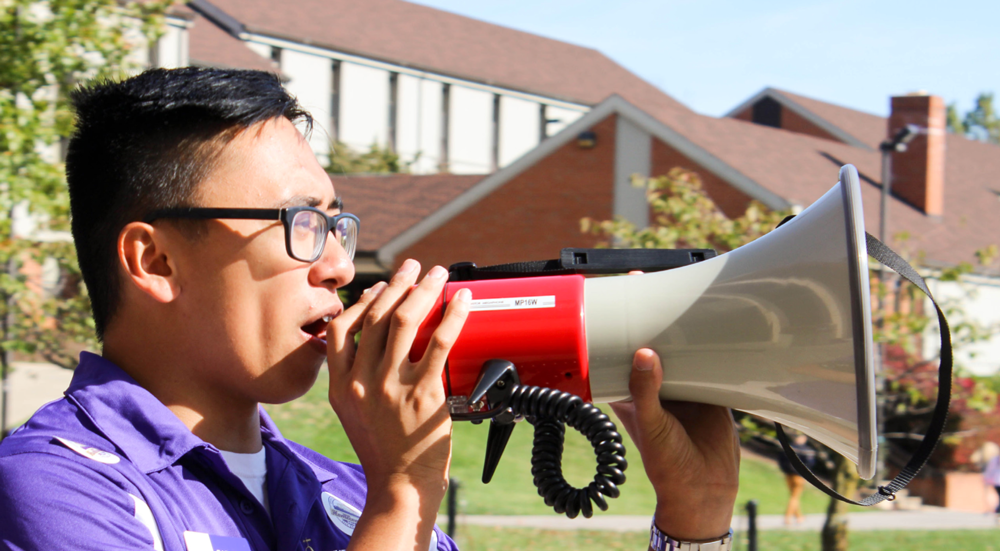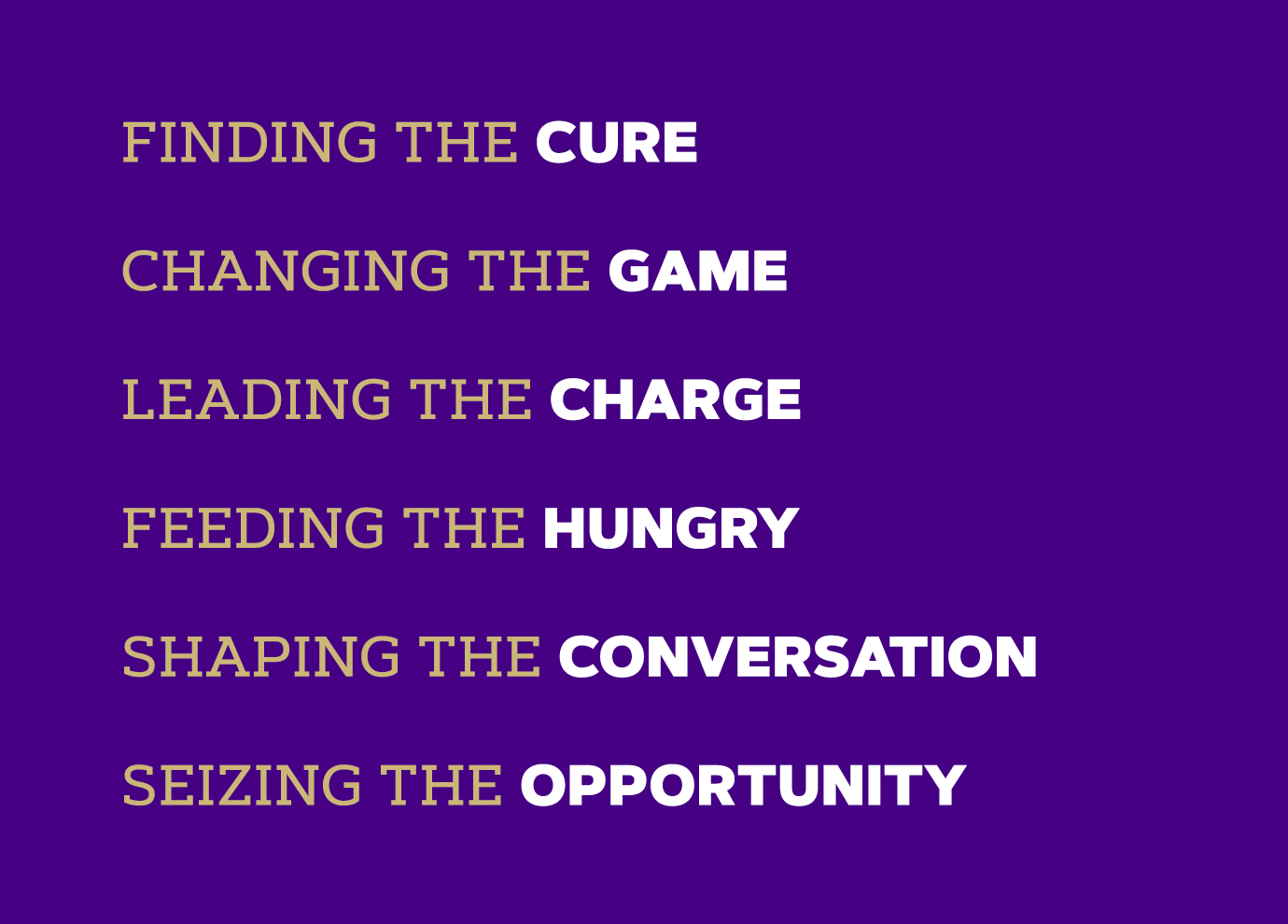
Being the Change®
The intent of adopting "being the change" as a tagline is to focus all of our campus communicators to portray success as being equal parts intellect and action.
Being the Change as a tagline is very much about action and initiative, so any public-facing communications should capture that spirit. Stories about students, faculty, programs, activities and alumni should focus on Being the Change, even if those words aren’t expressly used. Narrative copy and other descriptions of any programs or events at JMU should use active voice and relate back to the values of engagement, impact and citizenship. At the same time, they should capture the spirit of initiative, excitement and fun with which our students, faculty and alumni approach their work.
Sample words & uses
In keeping with the brand, action verbs should dominate JMU’s communications. (As suggested in the examples, the “-ing” form of action verbs may be appropriate to echo the tagline.) Selected verbs and adjectives that would be appropriate for communications appear in the chart on the right.
In some cases, it will be appropriate to use the phrase Being the Change in outward-facing communications. Two examples are shown below. At the same time, there is some risk of overusing this phrase; it is more important to convey the spirit of the tagline than to use these exact words.
Verbs
|
|
Adjectives
|
|
Sample #1
Ahmad Abdul-Ali ('12) fled war-torn Afghanistan as a child and moved with his family to Turkmenistan and, ultimately, Virginia. He credits his JMU professors with supporting his dream of going to medical school and showing him the way. Now a first-year medical resident, he hopes to pursue a career as a general surgeon in an underserved rural community, helping people who would otherwise face long delays or long-distance travel for procedures. Dr. Abdul-Ali is Being the Change.
Sample #2
Challenges such as deforestation and climate change are daunting, to say the least, but biology major Anna Nordseth ('17) has her mind set on Being the Change. She studied these issues up close in Costa Rica and Panama and researched how agroforestry — growing trees or shrubs around or among crops or pastureland — might help blunt the effects of deforestation on rising carbon levels. Whether she pursues a career in academia or with a conservation organization, Anna’s vision is clear: “The bottom line is that I want to do whatever I can do that has the most impact.”
A powerful component of Being the Change is using doing the thing phrases that parallel its construction. A few examples are shown in the purple box.
These examples could be used on their own or in combination with Being the Change, such as:
Finding the Cure. Being the Change. Shaping the Conversation. Being the Change.
The beauty of the tagline Being the Change in combination with doing the thing phrases is its flexibility. The concept can be applied to every discipline and pursuit. It’s nearly infinite combinations unites the incredible diversity of activity on campus into a universal that has power and meaning.

Writing guidelines
Together, the following three reference guides constitute Madison Style, the official editorial style for all non-academic JMU print and digital communications:
- The current Associated Press Stylebook - (only available from JMU's internal network) Available at the JMU Bookstore or another bookstore of your choice.
- Webster’s New World College Dictionary - JMU’s official first dictionary reference for usage and meaning.
- A to Z Guide - Our house style guide shows where Madison Style differs from AP Style, offers solutions to commonly queried and misused style points, and addresses style issues unique to James Madison University marketing and branding.
Grammar, punctuation, and writing guides
The following grammar, punctuation and writing guides offer helpful tips and commonsensical advice for good writing:
- Line by Line by Claire Kehrwald Cook
- Elements of Style by William Strunk Jr. and E.B. White
- Dictionary of Troublesome Words by Bill Bryson
- Lapsing into a Comma by Bill Walsh
Pronouns and gender-inclusive language
In keeping with JMU's commitment to diversity, equity and inclusion, every attempt should be made to honor a person's gender identity and expression. Gender should never be assumed based on a person's first name or appearance. Some members of the JMU Family may identify as both male and female, or neither, and some may prefer gender-neutral pronouns (they/them/their). If a person's choice of pronouns is not known, it is best to use they/them/their. Creating an opportunity during the interviewing process for the person to disclose their gender identity and choice of pronouns is recommended. The following websites serve as guides in the use of gender-inclusive language:
- MyPronouns.org is an excellent resource on how to use pronouns correctly.
- The United Nations outlines helpful guidelines for the use of gender-inclusive language.
Formal language
Madison Style does not address language used in invitations and other formal usages. There are several guides available that offer instruction on the use of etiquette and formal language. Please consult one of them and then use that guide consistently for usages that require formal language. The following guides may be helpful:
- Etiquette and Protocol: A Guide for Campus Events by April L. Harris (available through CASE bookstore)
- Etiquette by Peggy Post
Questions?
If you have questions or need more information contact the editorial staff at madisonstyle@jmu.edu.
Follows the general guidelines for writing text, except
Word/character count
- Homepages: a few short sentences, not long paragraphs. Homepages are meant to be a starting place, with links to pages containing more detail. Do not put long paragraphs on a homepage.
- Detail pages (non-Homepages): can have long paragraphs
- Articles: see guidelines in this document
- In general: use bulleted lists where appropriate to help readers scan
Justification
- Do not justify on BOTH right and left margins. This often causes spacing issues which in turn causes readability problems.
- Limit your use of centered text, especially for paragraphs. Centered text is ok for headings and brief sentences.
Resources
JMU Identity Guide
all the tools you need to create content for JMU
NNGroup web writing tips
great tips for making sure your page is readable


